| کد مقاله | کد نشریه | سال انتشار | مقاله انگلیسی | نسخه تمام متن |
|---|---|---|---|---|
| 332987 | 545892 | 2016 | 9 صفحه PDF | دانلود رایگان |
• Four profiles of comorbid internalizing syndromes were found.
• The overall high profile (OHp) reported the worst parenting and functioning.
• The high somatization (HSp) and moderately high (MHp) profiles had midway results.
• However, the MHp reported higher levels of harsh parenting than the OHp.
• The HSp and the OHp reported the highest disruptive and risk taking problems.
Understanding somatization presents a challenge to clinicians because it is often associated with other syndromes. We addressed somatization’s comorbidity with other internalizing syndromes (anxiety, depression, withdrawal) using latent profile analysis. A representative sample of 3496 Israeli middle and high-school youths reported their internalizing symptoms, perceived parenting practices, psychosocial functioning, and health behaviors. Four profiles, similar across age and gender, were identified: overall-low (65.4%), moderately-high anxiety/depression/withdrawal (24.4%), high somatization (4.8%), and overall-high (5.4%). MANOVAs and follow-up ANOVAs revealed that for the most part the overall-high profile evinced the worst parenting, psychosocial functioning, and health behaviors (smoking and drinking), while the overall-low group evinced the best. For most variables the high somatization and moderately high profiles displayed midway results. However, the moderately-high profile reported higher levels of harsh parenting than the high somatization profile. The high somatization profile reported similar or higher levels of smoking, risk taking, vandalism, and rule violation than the overall-high group. High somatization, either alone or alongside anxiety, depression, and withdrawal, was associated with disruptive and risk-taking behaviors. This link might reflect problems in emotion and anger regulation and become stronger in adolescence because of dysregulation processes characterizing this period. Implications for practice are discussed.
Journal: Psychiatry Research - Volume 244, 30 October 2016, Pages 10–18
